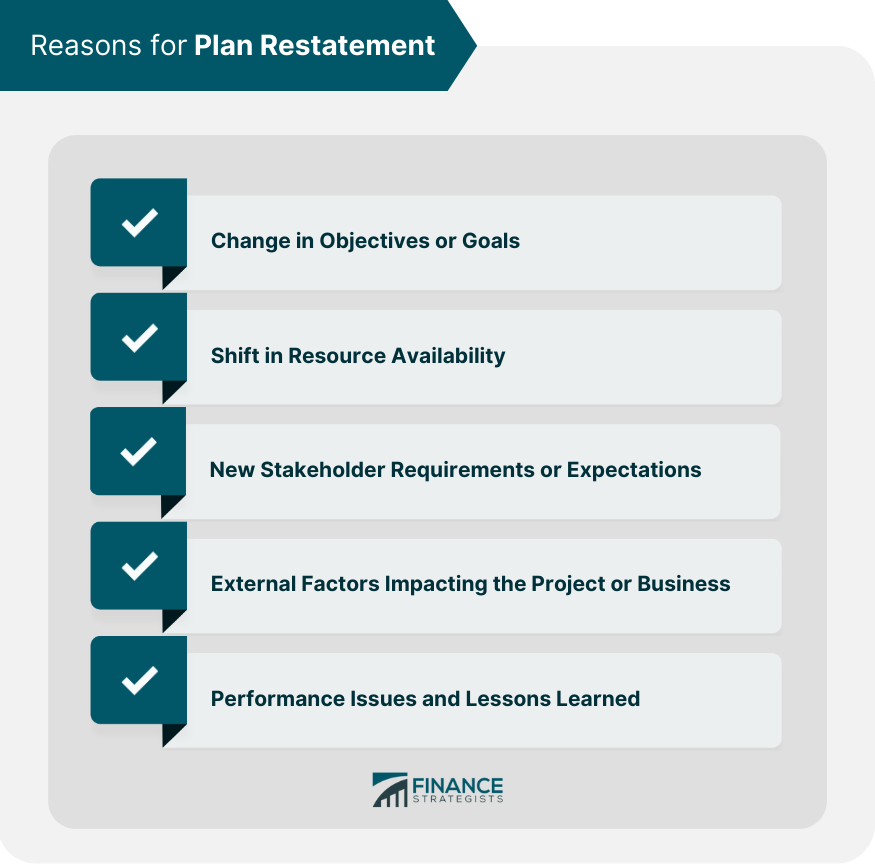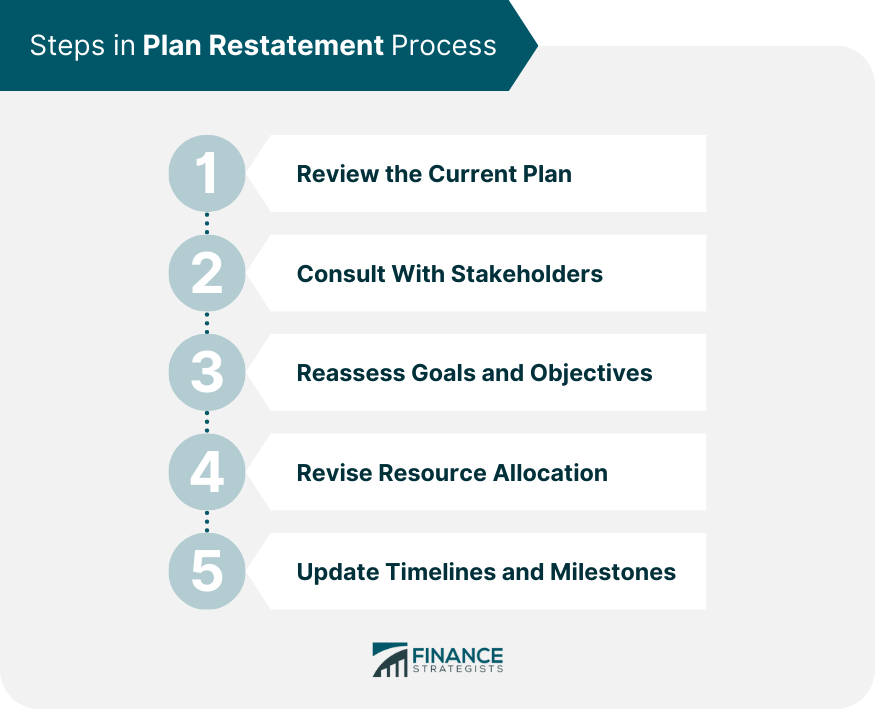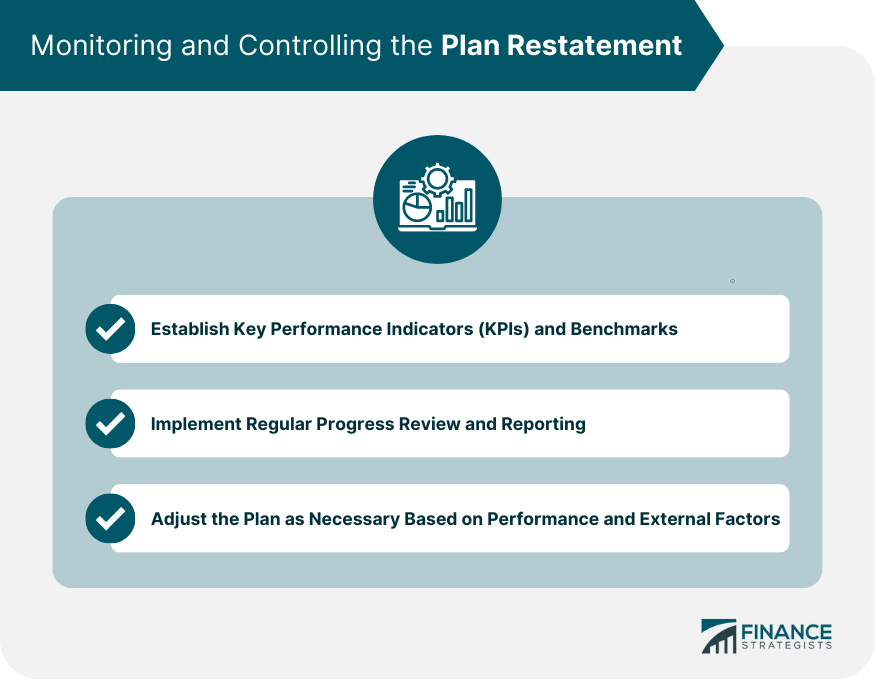Plan restatement refers to the process of revising and updating an existing project or business plan to address changes in objectives, resource availability, stakeholder expectations, or other factors that have emerged since the plan's initial implementation. Plan restatement plays a crucial role in ensuring that projects and business operations remain aligned with their goals and objectives, as well as adapting to the evolving needs of stakeholders and the ever-changing external environment. Over time, a project or business may experience shifts in its objectives or goals, necessitating a plan restatement. These changes may stem from evolving market conditions, stakeholder feedback, or a reevaluation of the organization's strategic direction. Resource availability can change due to budgetary constraints, personnel changes, or fluctuations in the availability of materials or technology. Plan restatement allows organizations to adapt their resource allocation strategies to these changes, ensuring continued progress toward their goals. Stakeholder requirements and expectations can evolve throughout the life of a project or business operation. Plan restatement ensures that the project or business remains responsive to these changing needs, maintaining alignment with stakeholder interests and expectations. Various external factors, such as changes in regulations, market conditions, or competitor actions, can impact the success of a project or business. A plan restatement helps organizations adapt to these external factors, adjusting their strategies and tactics as necessary to maintain progress. Projects and businesses may face performance issues or uncover lessons learned that necessitate a restatement of their plans. By revising the plan in response to these insights, organizations can address issues, apply lessons learned, and improve future performance. The first step in the plan restatement process involves reviewing the current plan to identify areas of success and failure. This analysis enables organizations to understand what aspects of the plan are working well and which need improvement. After identifying areas of success and failure, it is essential to analyze the causes of these discrepancies. Understanding the underlying reasons for these outcomes can help inform the plan restatement process and ensure that revised plans address these issues effectively. To effectively restate a plan, organizations must consult with their stakeholders to gather feedback on the current plan. This process ensures that stakeholder perspectives are considered during the restatement process, resulting in a plan that better meets their needs and expectations. Through consultation with stakeholders, organizations can identify any new expectations or requirements that have emerged since the initial plan was implemented. Incorporating these new expectations into the restated plan helps to maintain stakeholder alignment and support for the project or business operation. Once feedback has been gathered and analyzed, organizations must reassess their goals and objectives in light of this information. New goals should be defined based on the feedback, analysis, and any changes in the external environment that have occurred since the initial plan was developed. With new goals defined, organizations must align their objectives with these revised goals. This step ensures that the restated plan remains focused on achieving the organization's updated strategic priorities. Resource allocation should be revised in the restated plan to reflect new priorities that have emerged from the reassessment of goals and objectives. This involves adjusting the distribution of financial, human, and material resources to support the updated plan, ensuring that resource allocation aligns with the revised strategic direction and maximizes the chances of success. To ensure efficient use of resources, the restated plan should also include strategies to optimize resource utilization. This may involve reallocating underutilized resources, eliminating waste, or identifying more cost-effective alternatives to existing resource allocations. As part of the plan restatement process, it is necessary to update timelines and milestones to reflect the revised goals and objectives. This involves setting new deadlines for tasks and adjusting milestones to ensure that they align with the updated plan. Once new deadlines and milestones have been established, organizations must communicate these changes to all stakeholders. Clear communication ensures that everyone involved in the project or business operation understands the revised timelines and expectations, facilitating a smooth transition to the restated plan. During the plan restatement process, organizations should prioritize transparency and openness in their communication efforts. This involves sharing the rationale behind the changes, discussing the impact of the restatement on stakeholders, and maintaining an open dialogue throughout the process. To ensure effective communication, organizations should tailor their messages to the specific needs and preferences of each stakeholder group. This may involve using different communication channels, adjusting the tone and style of the message, or providing different levels of detail based on the audience's familiarity with the subject matter. Effective communication plays a critical role in minimizing resistance to change during the plan restatement process. By clearly articulating the reasons for the changes, addressing concerns, and highlighting the benefits of the restated plan, organizations can help stakeholders adapt to the new direction. Clear and consistent communication throughout the plan restatement process can help secure stakeholder buy-in, which is crucial for the successful implementation of the revised plan. Engaging stakeholders in the restatement process and addressing their concerns can build trust and foster a sense of ownership over the new plan. To effectively monitor and control the restated plan, organizations should establish key performance indicators (KPIs) and benchmarks. These metrics allow organizations to track progress toward their revised goals and objectives, ensuring that the restated plan remains on track. Implementing regular progress reviews and reporting ensures that stakeholders remain informed about the progress of the restated plan. These reviews can help identify potential issues or deviations from the plan, allowing organizations to take corrective action as needed. As the restated plan is implemented, organizations should be prepared to adjust the plan as needed based on performance and external factors. By continuously monitoring progress and remaining responsive to changes in the environment, organizations can ensure that their restated plans remain aligned with their strategic objectives. Plan restatement is a critical process in project management and business operations that involves revising and updating an existing plan to address changes in objectives, resource availability, stakeholder expectations, or other factors. The reasons for plan restatement can include changes in objectives or goals, shifts in resource availability, new stakeholder requirements or expectations, external factors impacting the project or business, and performance issues and lessons learned. The steps involved in plan restatement include reviewing the current plan, consulting with stakeholders, reassessing goals and objectives, revising resource allocation, and updating timelines and milestones. Effective communication is also essential during the plan restatement process to minimize resistance to change, secure stakeholder buy-in, and ensure a smooth transition to the restated plan. Finally, monitoring and controlling the plan restatement involves establishing KPIs and benchmarks, implementing regular progress reviews and reporting, and adjusting the plan as necessary based on performance and external factors. Overall, plan restatement is crucial to maintaining alignment with strategic objectives and adapting to the evolving needs of stakeholders and the external environment.What Is a Plan Restatement?
Reasons for Plan Restatement

Changes in Objectives or Goals
Shifts in Resource Availability
New Stakeholder Requirements or Expectations
External Factors Impacting the Project or Business
Performance Issues and Lessons Learned
Steps in Plan Restatement Process

Review the Current Plan
Identify Areas of Success and Failure
Analyze Causes of Discrepancies
Consult with Stakeholders
Gather Feedback on the Current Plan
Determine New Expectations and Requirements
Reassess Goals and Objectives
Define New Goals Based on Feedback and Analysis
Align Objectives with New Goals
Revise Resource Allocation
Reallocate Resources Based on New Priorities
Optimize Resource Utilization
Update Timelines and Milestones
Set New Deadlines and Milestones
Communicate Changes to All Stakeholders
Communicating Plan Restatement
Effective Communication Techniques
Transparency and Openness
Tailoring Messages to Specific Audiences
Role of Communication in Change Management
Minimizing Resistance to Change
Ensuring Stakeholder Buy-In
Monitoring and Controlling the Plan Restatement

Establish Key Performance Indicators (KPIs) and Benchmarks
Implement Regular Progress Review and Reporting
Adjust the Plan as Necessary Based on Performance and External Factors
Final Thoughts
Plan Restatement FAQs
Plan restatement serves to revise and update an existing project or business plan in response to changes in objectives, resource availability, stakeholder expectations, or other factors that have emerged since the plan's initial implementation. It helps organizations adapt their plans to maintain alignment with goals and improve performance.
Reasons for initiating a plan restatement process include changes in objectives or goals, shifts in resource availability, new stakeholder requirements or expectations, external factors impacting the project or business, and performance issues or lessons learned.
Effective communication during plan restatement ensures transparency and openness, minimizes resistance to change, and fosters stakeholder buy-in. By tailoring messages to specific audiences and maintaining clear communication throughout the process, organizations can secure support for the revised plan and facilitate a smooth transition.
The key steps in the plan restatement process include reviewing the current plan, consulting with stakeholders, reassessing goals and objectives, revising resource allocation, updating timelines and milestones, and communicating changes to all stakeholders.
Ongoing plan restatement is essential in a dynamic business environment because it allows organizations to remain agile and responsive to change. By continuously monitoring progress and adapting their plans as needed, organizations can ensure that their plans stay aligned with their strategic objectives and maintain their competitive edge in an ever-changing landscape.
True Tamplin is a published author, public speaker, CEO of UpDigital, and founder of Finance Strategists.
True is a Certified Educator in Personal Finance (CEPF®), author of The Handy Financial Ratios Guide, a member of the Society for Advancing Business Editing and Writing, contributes to his financial education site, Finance Strategists, and has spoken to various financial communities such as the CFA Institute, as well as university students like his Alma mater, Biola University, where he received a bachelor of science in business and data analytics.
To learn more about True, visit his personal website or view his author profiles on Amazon, Nasdaq and Forbes.















